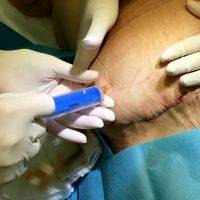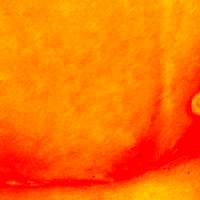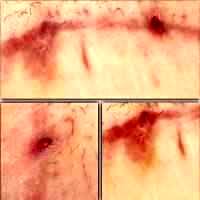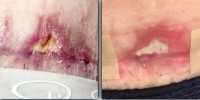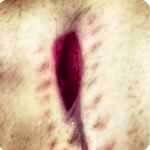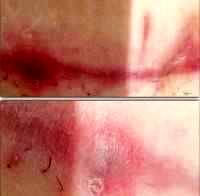Seroma after tummy tuck
Complications after abdominoplasty: seroma
Surgical tummy tuck refers to prolonged and traumatic operations. After its completion, you should closely monitor the condition of the body. Unprofessional actions of the surgeon, individual healing features or concomitant diseases can lead to the development of various complications, one of which is seromy after abdominoplasty.Seroma after abdominoplasty is the accumulation of lymph in the area of the operating wound.
Normally, it resolves within a few weeks, but pathologically large accumulation causes stretching and sagging of the skin, which leads to uncomfortable sensations, a long rehabilitation period, frequent visits to the doctor and additional expenses.
Seroma after abdominoplasty: causes of formation
Seroma is often diagnosed after classical abdominoplasty, as this operation involves a long incision of the tissues. Lymph flow is due to damage to a large number of vessels, which does not have the properties of coagulation and thrombosis.Other factors include:
- Sloppy work of the surgeon – seroma after abdominoplasty occurs with rough actions of the doctor, using tools with the effect of crushing, a specialist must make a cut in one motion, otherwise numerous incisions will increase the area of damage;
- Excessive coagulation – cauterization is advisable to apply only in case of vessel damage, since any burn is always accompanied by the release of inflammatory fluid, which increases the process of formation of such complications as seroma after abdominoplasty;
- Obesity – seroma after abdominoplasty will occur with a probability of more than 50% if the size of fatty tissue exceeds 5 centimeters. Usually, the doctor advises the patient to lose weight or undergo a liposuction procedure before the surgery. In this case, the aesthetic result will become more noticeable.
Symptoms
Seroma after abdominoplasty is manifested by the following symptoms:
- Swelling in the lower abdomen;
- Sensation of transfusion of liquid during movement;
- Pain of a pulling character when the torso is straightened;
- Increase in body temperature to 38 C;
- Redness in the seam area;
- Increased fatigue, weakness.
Methods of treatment
There are several methods of treating this pathological condition.
With the help of medications – antibiotics of wide action do not allow suppuration of the problem zone, anti-inflammatory drugs reduce the amount of exudate and accelerate the healing.Punctures – with the help of a special syringe the specialist can at once remove from 30-40 to 400-500 milliliters of liquid. To completely eliminate the problem, it is enough to hold 5-7 sessions with breaks in two days.
Vacuum aspiration – seroma after abdominoplasty with the help of a special device for vacuum suction of exudate. To it, attach a flexible hose, which is introduced into the lower section of the edema.
Drainage – the patient lies on his back, and the doctor in the seam zone or through small punctures alongside sets up a drainage tube, descending into the vessel for lymph drainage.
Abdominoplasty and seroma will not become synonyms for you if you choose a good clinic with professional surgeons and modern equipment. After the operation, wear a medical bandage, limit physical activity, follow all the doctor’s instructions, and if any discomfort occurs, urgently seek help.
In this case, the recovery period after plastic surgery will pass without complications and as soon as possible.
What is a seroma after tummy tuck?
Seroma – is abnormal accumulation of serous fluid that sometimes develops after surgery. Very often it is formed after the big cuts, such as mastectomy, breast augmentation, abdominoplasty and lifting the body or face. Seroma usually resorbed itself within a few weeks.
But accumulation of fluid stretches the skin and causes it to sagging, and this in turn causes discomfort and anxiety, and as a consequence – a long period of recovery, stay in hospital, more frequent visits to the doctor and additional expenses. The formation of seroma can be affected by various factors, but their role in pathogenesis is different for all patients. To prevent seroma after a tummy tuck, it is important to understand how it appears.
Seroma after abdominoplasty is the accumulation of serous exudate in the subcutaneous tissue of sewn wound in the form of a cavity.
In obese patients, especially when in the course of surgical intervention arises pronounced damage or delamination of subcutaneous fat from the musculo-aponeurotic layer over a large area. In the wound may form a cavity filled with a straw-colored liquid. This is due to the large traumatization of the soft tissue, including lymph vessels.
Seroma is manifested by the fact that after 2-3 days after a tummy tuck surgery, the patients start to complain about discomfort in the wound, sometimes there are minor pain from time to time – subfebrilitet. At palpation determined almost painless infiltration of the aponeurosis.
When and why arises seroma?
Pathophysiology of seroma after tummy tuck is not well studied, but presumably the main cause of the accumulation of lymphatic fluid is a violation of the lymphatic capillaries. Also considered that the seroma is more than a simple accumulation of serum.
Perhaps it occurs because of acute inflammation of fluid levels. During surgery, the surrounding tissue and blood vessels are injured. As a reaction to trauma, inflammation occurs in a place that is exposed to surgery.
In other words, the body is filled with lymph, under the influence of pain and swelling that occur after tummy tuck surgery. Sometimes, due to damage to the channels, instead of reducing the amount, lymph accumulates, which leads to the formation of seroma.
Patients should be aware of the possibility of formation of seroma after tummy tuck. Usually they are often examine a place that has undergone surgery for complications. Although seroma and not very dangerous, it can lead to serious complications such as skin flap necrosis, delayed wound healing, infection, susceptibility to sepsis and lymphedema. Seroma formation may also be due to factors such as age, weight, diabetes in the patient’s medical history and high blood pressure.
- Tummy tuck seroma surgery
- Tummy tuck seroma after surgery
- Seroma tummy tuck big photo
Abdominoplasty is one of the procedures, after which seroma may occur. According to the studies, the probability of occurrence of seroma after tummy tuck ranges from 5% to 50%. It was also noted that some patients have a tendency to forming of seroma. This can happen due to a large skin incision on the abdomen and violations vessels and lymph channels.
Solution of seroma after tummy tuck
A large number of surgical techniques and technologies have been developed to reduce the probability of formation of seroma. Small seroma often go unnoticed and are absorbed on their own, but if seroma is not treated, it can harden and turn into a tight knot. Large size seroma often require extraction with a special needle, whereas intractable seroma require vacuum drainage.
Seroma can be infected, therefore requires treatment with antibiotics, and in some cases, surgery is required. However, preventing the emergence of seroma is the best solution to the problem. Drainage – it is one of the most suitable and versatile methods. Even little use of the drainage system reduces or even prevents seroma. Overlay compresses also helps prevent seroma and is often used by some surgeons.
The presence of infiltration in the wound area is an absolute indication for its revision: 1-2 skin sutures are removed above the infiltration, wound edges divorced in hand with the help of forceps or clamp, evacuated the wound contents. Seroma cavity for 1-2 days is drained by a rubber band. In order to prevent the development of wound infection, briefly appointed antibiotic therapy.
Prevention of seroma after tummy tuck:
- careful wound closure of the abdominal wall without leaving pockets;
- different types of vacuum drainage, including active aspiration of wound by Redon (drainage, harmonica);
- compression bandage or load on the wound area (bag of sand) for a few hours.
The incidence of septic complications of surgical wounds is largely determined by the presence of initial infection.
It should be noted that the inflammatory complications of wounds in the immediate postoperative period, often associated with the contact or by lymphatic spread of infection, in the late period – with implant contamination (suture material).
Septic wound complications can be detected in the serous infiltration step (infiltration) or purulent necrotic.
In the presence of infiltrate is performed revision wound with the help bellied probe. Patients are assigned: intensive antibiotic therapy, UHF, electrophoresis with Dimexidum, made short block novocaine solution with antibiotics.
In purulent-septic stage of the process the wound opens wide, washed with a solution of chlorhexidine or furacilinum, subjected to ultrasonic cavitation, then drained by tubular drains through which occurs fractional lavage of wound cavity or entered tampons with hypertonic (10%) sodium chloride solution. Conducted intensive antibiotic therapy and detoxification therapy.
Removal of seroma
Seroma after tummy tuck – a complication or inevitability?
Accumulation of fluid in the subcutaneous tissue after surgery causes in surgeons a controversial opinion, although the vast majority of doctors perceive this phenomenon as a complication.
Any surgery pathogenetically accompanied by alteration – significant tissue damage. Alteration represents a first step in the development of the inflammatory process. As a result of dissection, are opened extensive lymphatic collector and small blood vessels. Therefore, for any course of surgery, blood and lymph pour down on the wound surface, creating a favorable environment for microbes.
The next step is the development of inflammation. This step is a surgical inevitable, with which you need to fight in order to prevent the appearance of purulent inflammation. Note that the elimination of the cavity is not possible, so the only option is its division into several smaller ones.
To combat seroma after tummy tuck is used injection-vacuum drainage and puncture method. The point is that the accumulation of serous fluid is an individual process and can last up to several months. After studying sequential of a punctate we identified a gradual quantitative and qualitative changes in the composition of the liquid (which ranges from 150-200ml hemorrhagic with the hemoglobin 42 g/L, protein 38 g/L to 20-25ml, 0.5 g/L, 12 g/L, and others.).

